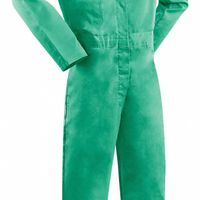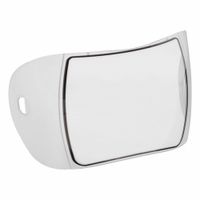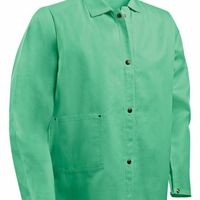Call +(254) 703 030 000 / 751 483 999 / 721 704 777
- Home
- Safety
- Protective Clothing
- Welding Protective Clothing
.....Read More
Frequently Asked Questions
What materials are used in welding protective clothing?
Welding protective clothing is designed to protect welders from hazards such as heat, sparks, and molten metal. The materials used in these garments are chosen for their durability, heat resistance, and protective qualities. Common materials include:
1. **Leather**: Often used for welding jackets, gloves, and aprons, leather is highly resistant to heat, sparks, and abrasion. It provides excellent protection and durability, making it a popular choice for heavy-duty welding tasks.
2. **Cotton**: Treated cotton is used for welding clothing due to its breathability and comfort. It is often treated with flame-retardant chemicals to enhance its protective properties. This material is suitable for lighter welding tasks.
3. **Kevlar**: Known for its high tensile strength and heat resistance, Kevlar is used in gloves and other protective gear. It provides excellent cut and puncture resistance, making it ideal for handling sharp objects and hot materials.
4. **Aluminized Fabrics**: These materials have a reflective surface that deflects radiant heat. They are used in clothing designed for high-temperature environments, providing protection against extreme heat and molten metal splashes.
5. **Wool**: Naturally flame-resistant, wool is sometimes used in welding clothing. It provides good insulation and protection against sparks and moderate heat.
6. **Nylon and Polyester Blends**: These synthetic fibers are often blended with other materials to enhance durability and resistance to wear and tear. However, they must be treated to be flame-retardant, as they can melt when exposed to high heat.
7. **Carbon Fiber**: Used in high-performance protective gear, carbon fiber offers excellent heat resistance and strength. It is lightweight and provides superior protection against extreme conditions.
These materials are often combined to create multi-layered protective clothing that offers comprehensive protection while maintaining comfort and flexibility for the welder.
How do welding helmets protect against UV light?
Welding helmets protect against UV light primarily through the use of specialized lens technology and materials that block or filter ultraviolet radiation. The lens of a welding helmet is typically made from polycarbonate or other UV-resistant materials that inherently block UV rays. These materials are designed to absorb and reflect UV radiation, preventing it from reaching the welder's eyes and skin.
Additionally, welding helmets often feature auto-darkening filters (ADF) that automatically adjust the shade of the lens in response to the intensity of the welding arc. These filters contain liquid crystal displays (LCDs) and polarizing filters that change their opacity when exposed to the bright light of welding. The ADF technology ensures that the welder's eyes are protected from both the intense visible light and the harmful UV and infrared radiation emitted during welding.
The helmet's design also plays a crucial role in protection. It covers the entire face and neck, shielding the skin from UV exposure. The helmet's shell is typically made from durable, heat-resistant materials that further block UV radiation.
In summary, welding helmets protect against UV light through a combination of UV-blocking materials, auto-darkening filters, and comprehensive coverage of the face and neck, ensuring that both the eyes and skin are safeguarded from harmful radiation during welding activities.
What is the difference between leather and flame-resistant fabric in welding gear?
Leather and flame-resistant fabric are both used in welding gear, but they serve different purposes and have distinct characteristics.
Leather is a natural material known for its durability, flexibility, and heat resistance. It provides excellent protection against sparks, spatter, and moderate heat, making it a popular choice for welding gloves, jackets, and aprons. Leather is thick and can withstand abrasion, offering a high level of physical protection. However, it can be heavy and may become stiff over time, especially if exposed to moisture.
Flame-resistant fabric, on the other hand, is typically made from synthetic materials like aramid fibers (e.g., Nomex, Kevlar) or treated cotton. These fabrics are designed to resist ignition and self-extinguish when exposed to flames. They are lighter and more breathable than leather, providing comfort during extended wear. Flame-resistant fabrics are often used in welding shirts, pants, and coveralls. They offer good protection against heat and flames but may not be as durable against physical abrasion as leather.
In summary, leather is preferred for its durability and heat resistance, ideal for high-contact areas, while flame-resistant fabric offers comfort and flame protection, suitable for full-body coverage. The choice between the two depends on the specific needs of the welding task and the environment.
Why is it important to wear protective clothing while welding?
Wearing protective clothing while welding is crucial for several reasons. Firstly, welding involves high temperatures and the emission of intense ultraviolet (UV) and infrared (IR) radiation, which can cause severe burns and skin damage. Protective clothing, such as flame-resistant jackets and pants, shields the skin from these harmful effects, preventing burns and long-term skin damage.
Secondly, welding produces sparks, spatter, and molten metal droplets that can cause serious injuries. Protective gear, including leather gloves and aprons, provides a barrier against these hazards, reducing the risk of burns and cuts. Additionally, welding helmets with face shields protect the eyes and face from flying debris and intense light, preventing eye injuries and conditions like "welder's flash" or photokeratitis.
Moreover, welding generates toxic fumes and gases that can be harmful if inhaled. While protective clothing does not replace the need for proper ventilation or respiratory protection, it can help minimize skin exposure to these substances. Long sleeves and high collars prevent fumes from coming into direct contact with the skin, reducing the risk of irritation and allergic reactions.
Furthermore, wearing appropriate footwear, such as steel-toed boots, protects the feet from heavy objects and hot materials that may fall during the welding process. This is essential for preventing foot injuries and ensuring overall safety in the workplace.
Lastly, protective clothing contributes to a professional and safety-conscious work environment. It signals to others that safety is a priority, promoting a culture of caution and responsibility. In summary, wearing protective clothing while welding is vital for safeguarding against burns, injuries, and exposure to harmful substances, ensuring the welder's safety and well-being.
How do you choose the right welding helmet?
To choose the right welding helmet, consider the following factors:
1. **Type of Lens**: Decide between a passive or auto-darkening lens. Passive lenses have a fixed shade, while auto-darkening lenses adjust to the brightness of the arc, offering more convenience and protection.
2. **Shade Range**: Ensure the helmet provides the appropriate shade range for the type of welding you do. Auto-darkening helmets typically offer a range from shade 9 to 13, suitable for most welding tasks.
3. **Reaction Time**: Look for a helmet with a fast reaction time to switch from light to dark. A quicker response time reduces eye strain and increases comfort.
4. **Viewing Area**: A larger viewing area provides better visibility and reduces the need to move your head frequently. Choose a helmet with a viewing area that suits your work requirements.
5. **Sensitivity and Delay Controls**: These features allow you to adjust the helmet's response to different lighting conditions and control how long the lens stays dark after the arc stops.
6. **Weight and Comfort**: A lightweight helmet reduces neck strain during long welding sessions. Look for adjustable headgear for a comfortable fit.
7. **Power Source**: Auto-darkening helmets can be powered by batteries, solar power, or a combination. Consider the convenience and availability of power sources.
8. **Safety Standards**: Ensure the helmet meets safety standards such as ANSI Z87.1 in the U.S. or EN379 in Europe, which guarantee adequate protection.
9. **Durability and Material**: Choose a helmet made from durable materials that can withstand the rigors of welding environments.
10. **Price and Brand**: Consider your budget and opt for reputable brands known for quality and reliability.
By evaluating these factors, you can select a welding helmet that offers optimal protection, comfort, and functionality for your specific needs.
Can welding helmets protect against all types of eye damage?
Welding helmets are designed to protect against specific types of eye damage associated with welding activities, but they do not protect against all possible eye injuries. They primarily shield the eyes from intense ultraviolet (UV) and infrared (IR) radiation, as well as visible light emitted during welding processes. The auto-darkening feature in many modern helmets adjusts the lens shade to protect against these harmful rays, preventing conditions like welder's flash or photokeratitis, which is akin to a sunburn on the cornea.
However, welding helmets are not foolproof against all eye injuries. They are not designed to protect against physical impacts or flying debris unless they are specifically rated for such protection. For comprehensive safety, helmets should meet standards like ANSI Z87.1, which ensures impact resistance. Additionally, helmets do not protect against chemical splashes or exposure to toxic fumes, which can also harm the eyes. In environments where these risks are present, additional protective measures, such as safety goggles or face shields, may be necessary.
Moreover, improper use or maintenance of welding helmets can compromise their protective capabilities. For instance, using a helmet with a damaged lens or an incorrect shade setting can lead to insufficient protection. It's crucial for users to select the appropriate helmet for the specific welding task and ensure it is in good working condition.
In summary, while welding helmets are effective in protecting against radiation-related eye damage, they are not a catch-all solution for every type of eye injury. Users must assess the specific hazards of their work environment and use additional protective equipment as needed to ensure comprehensive eye safety.
What are the safety standards for welding protective gear?
Safety standards for welding protective gear are designed to protect workers from hazards such as burns, eye damage, and inhalation of harmful fumes. Key standards include:
1. **Eye and Face Protection**: ANSI Z87.1 specifies requirements for safety glasses, goggles, and face shields to protect against UV radiation, sparks, and debris. Helmets with appropriate filter lenses are essential to shield eyes from intense light and radiation.
2. **Respiratory Protection**: OSHA 29 CFR 1910.134 mandates the use of respirators when ventilation is inadequate. NIOSH-approved respirators are recommended to prevent inhalation of toxic fumes and gases.
3. **Protective Clothing**: Clothing should be flame-resistant, as per NFPA 2112, to protect against sparks and heat. Leather or heavy cotton garments are preferred, and they should cover all exposed skin.
4. **Gloves**: Gloves must be heat-resistant and provide dexterity. Standards like EN 12477 specify requirements for welding gloves, ensuring they offer protection against thermal and mechanical risks.
5. **Foot Protection**: ANSI Z41 or ASTM F2413 standards require steel-toed boots to protect feet from falling objects and punctures, with additional heat resistance for welding environments.
6. **Hearing Protection**: OSHA 29 CFR 1910.95 outlines the need for ear protection in noisy environments to prevent hearing loss.
7. **General Safety**: ISO 11611 provides guidelines for protective clothing used in welding and allied processes, ensuring comprehensive protection against various hazards.
Compliance with these standards ensures that welding protective gear effectively minimizes risks, promoting a safer working environment. Regular training and equipment maintenance are also crucial to uphold safety standards.








